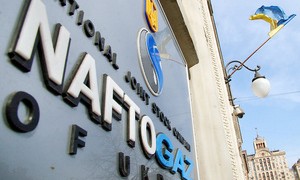
Ukraine Rapidly Dismantling Gazprom’s Supply Monopoly
Publication: Eurasia Daily Monitor Volume: 12 Issue: 65
By:

Quantitative indicators show a dramatic reorientation of Ukraine’s natural gas supply strategy. Dependence on Gazprom has become a thing of the past. Kyiv demonstrates political resolve to pursue supply diversification and adapt to changing market conditions with the European Commission’s backing.
Along with supply diversification, Ukraine’s business practices in the gas trade with Russia are also changing momentously. For the first time in independent Ukraine, the current political leaders have no corporate or personal interest in the gas business, nor do they depend on interest groups linked to the energy sector. And also for the first time, Ukraine’s state leadership is no longer involved in what used to be highly politicized negotiations with the Kremlin over gas supplies. Instead, Kyiv treats this as a business matter, to be handled by the Ministry of Energy and Naftohaz Ukrainy (itself due for restructuring), in contrast to the Kremlin leaders who continue personally to handle the gas trade with Ukraine as a matter of state for Russia (see EDM, April 3, 6).
Gazprom had traditionally supplied almost 100 percent of independent Ukraine’s annual gas imports. Gazprom accounted for 95 percent of Ukraine’s imports as late as 2013. Gazprom’s share in 2014 was still dangerously high, at almost 75 percent of Ukraine’s gas imports, but the country procured the remainder through reverse flows from Europe. Of 19.5 billion cubic meters (bcm) of gas that Ukraine imported in 2014, Russia supplied 14.5 bcm; whereas 5.1 bcm entered Ukraine through interconnections from Slovakia (3.6 bcm), Poland (0.9 bcm), and Hungary (0.6 bcm). Gazprom’s share could have been higher in 2014, but Moscow had suspended all gas deliveries to Ukraine from June through October 2014 (Interfax, April 1, 2, 2015).
Meanwhile, pipeline capacity expansion in Slovakia made it possible for Ukraine to increase gas import volumes from that direction significantly; and the “reverse” gas was winning in the price competition over Gazprom’s (see below). In February 2015, the reverse flow from Europe exceeded the direct flow from Russia for the first time in terms of monthly volumes (Interfax, March 4); and the trend looks set to continue on a quarterly and annual basis.
In the first quarter of 2015 (January 1–March 31), Ukraine procured 3.65 bcm from European markets (almost entirely via Slovakia), exceeding the 2.16 bcm imported from Gazprom during the quarter just past. Compared with the first quarter of 2014, when Gazprom’s market share stood at 100 percent in Ukraine, the change in the first quarter of 2015 looks downright revolutionary in terms of Ukraine’s supply diversification (Ukrinform, UNIAN, April 2).
According to the energy ministry and Naftohaz, Ukraine plans to import 26 bcm of gas during the calendar year 2015, with Gazprom to account for 40 percent and European suppliers for 60 percent of that annual volume (Dzerkalo Tyzhnya, Zn.ua, April 4; Ukrinform, UNIAN, April 6).
Construction of the Slovakian-Ukrainian pipeline interconnector, Vojany-Uzhhorod, and the expansion of its capacity is of decisive importance in sustaining Ukraine’s diversification of gas supplies. The Vojany-Uzhhorod began operating at full throttle in September 2014, and underwent an expansion of its capacity, from 11.5 bcm to 14.5 bcm in annual terms, by February 2015 (Interfax, March 1). The increased capacity equals one third of Ukraine’s annual consumption of gas at present; and its flow (if activated near full capacity) would exceed Ukraine’s import volume of Russian gas planned for 2015 (see above).
As Ukrainian and Slovakian leaders have noted in this connection, both countries are determined to retain their status as transit countries for natural gas. In Ukraine’s case, this is Russian gas en route to Europe through the Ukrainian transit system. Slovakia’s case is different, however. For decades, the country’s transit pipelines had functioned as the westward extension of Ukraine’s transit system. With a comparably gigantic capacity at 120 bcm annually in four parallel lines, operated by Eustream, the Slovakian system is currently utilized far below capacity (see below).
The Kremlin’s decisions to bypass Ukraine via Nord Stream and (declaratively) South Stream or its modified version, Turkish Stream, threaten ipso facto to bypass Slovakia more drastically, if not entirely. Gazprom’s transit volumes via Slovakia have declined abruptly in recent years, as Europe’s recession capped demand for natural gas while liquefied gas and spot-market competitors challenged Gazprom on the market.
Conversely, the gas flow in reverse from Europe to Ukraine enables Slovakia to retain its status as a transit country. That reverse flow consists mainly of Russian gas originally sold by Gazprom to European companies and re-sold by these to Ukraine via Slovakia. Of these, the Velke Kapusany-Uzhhorod connection could have provided the “big reverse” option to Ukraine, with a volume of 30 bcm annually. That option envisages a dedicated use of one of Eustream’s four parallel lines in Slovakia, or at least unimpeded access to it, and connecting with Velke Kapusany-Uzhhorod for the “big reverse transit” to Ukraine. That access has not worked out as needed, however. Eustream seems to be constrained in its decisions by the terms of its transit contract with Gazprom (Natualgaseurope.com, accessed March 7).




